
When you come to Shanghai by plane, we will provide intimate services to make your journey more convenient and comfortable, such as picking up the plane and taking you to the hotel.
Shanghai is a magic city. Here, Eastern and Western cultures blend with each other, Western architecture and skyscrapers are blooming their own charm.
Today, our trip is beginning. Firstly, we are going to the Jade Buddha Temple.
The temple is mainly dedicated to the Jade Buddha, so it is named Jade Buddha Temple. Although it is located in the busy city, it is quiet in the busy city.
What is more famous is the two jade Buddhas that Master Huigen brought back from Burma in the Qing Dynasty (1636-1912). One is a 1.92-meter-high statue of Sakyamuni sitting Buddha, the body of the Buddha with gold foil and inlaid with brilliant gems. It is the treasure of the temple. Another is a 96-centimeter-long statue of Sakyamuni reclining Buddha, whichi is made according to the pattern of Sakyamuni's death. It lay on its side, the head propped up by right hand, looking serene.
Then, we will go to the Yu Garden (closed each Monday).
Located in the heart of Shanghai, Yu Garden was a private garden during the Ming Dynasty (1368-1644). Established in 1559, the garden fully demonstrates the architectural and design style of Chinese classical gardens. Sansui Hall is the main scenic spot. The big rockery here is about 14 meters high, carefully designed by Zhang Nanyang, a famous mountain builder in Ming Dynasty, which is also his only surviving work.
After lunch, we will go to the Shanghai Tower.
Shanghai Tower is the tallest skyscraper in China and the second tallest in the world. The 118-storey sightseeing hall at the top of Shanghai is the functional experience area of Shanghai Center Building, surrounded by a large transparent glass curtain wall. You can see the Oriental Pearl Tower and the World Financial Center at close range from the 360-degree full-view sightseeing hall at the top of Shanghai.
At night, the Shanghai Tower and the nearby Oriental Pearl and Shanghai Global Financial Center constitute the most shocking and charming night view of Lujiazui Financial Center.
Then, we are arriving in the Nanjing Road. It is one of the ten famous pedestrian streets in China and the earliest commercial street in Shanghai. This is the gathering place of department stores, with a wide range of goods, which is a shopper's paradise. Here, there are creative urban sculptures everywhere, and there are a large number of chairs in the middle of the street for tourists to sit, full of literary and artistic fashion.
After walking through Nanjing Road, we came to the Bund. Dozens of classical buildings of different styles stand on the Bund. The Bank of China, Peace Hotel and HSBC Bank have reappeared their former elegance.
Optional Activities:
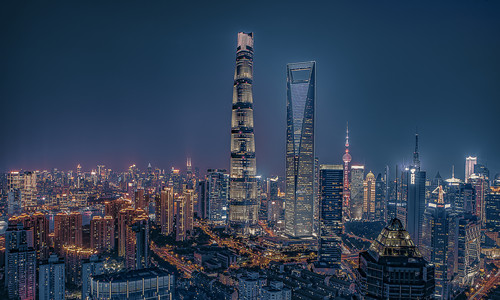
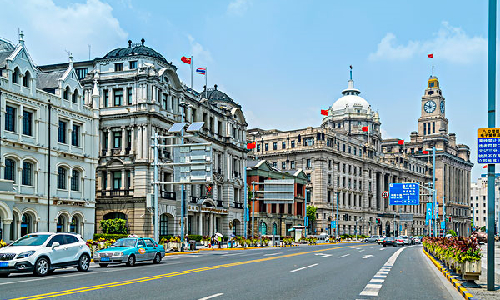
 Yichang
Yichang Yangtze River Cruise
Yangtze River Cruise Shanghai’s journey is come to an end and we will go to Yichang. We have booked estimated train D2212 07:32/15:21 for you. After you arrive in Yichang, the tour guide will wait for you at the station. Then, we will send you to the cruise and check in.
Our trip to Yichang is begin. If you have the habit of morning exercise, you should not miss Practice Tai Chi. (Every day before breakfast, has a teacher to lead and free of charge). Tai Chi refers to the boxing in Chinese martial arts, with the concept of Taiji and Yin and Yang in Chinese traditional Confucianism and Taoism philosophy as the core idea, which integrates many functions such as self-cultivation, body building and physical fitness.
After breakfast, we will go to Tribe of The Three Gorges or Hometown of Qu Yuan (at your own expense).
Tribe of The Three Gorges are located in the most fantastic and magnificent Xiling Gorge. It is surrounded by mountains and rivers and has a picturesque scenery. When you enter here, it seems to enter the ancient and mysterious paradise, people can once again explore the historical relics.
Next, we will go to the Hometown of Qu, which was built in memory of the great ancient Chinese poet Qu Yuan. Qu Yuan is a famous poet of Chu State. Legend has it that after he jumped into the Miluo River, a golden God fish swallowed his body, swam to the end of the Xiangxi River and then spit it out. The Xiangxi River ended near Qu Yuan's hometown, where his sister buried his body and settled down. In 1978, when the Gezhouba Water Conservancy Project was built, it was moved to Xiangjiaping Village and rebuilt according to its original appearance.
(Tip: If the water level changes and the cruise can not dock on the shore, we will cancel the trip.)
After lunch, you can choose to board sightseeing-ferry sailing through TGP ship’s elevator at your own expense.
Next, we will go ashore to visit the world’s largest hydropower project-Three Gorges Dam. It is not only a huge wall for flood control, but also a huge reservoir, a powerful generator and a large channel for shipping and logistics.
When you return to the cruise ship after the tour, you can enjoy dinner. Not only can you have dinner while enjoying the beautiful scenery, but you can also experience the captain's welcome reception. The captain will raise a glass to all the visitors. After that, while eating snacks and drinking champagne, we began to enjoy performances such as national dance, folk music ensemble, acrobatics and so on.
(Tip: Itineraries and parties may vary slightly depending on your ship.)
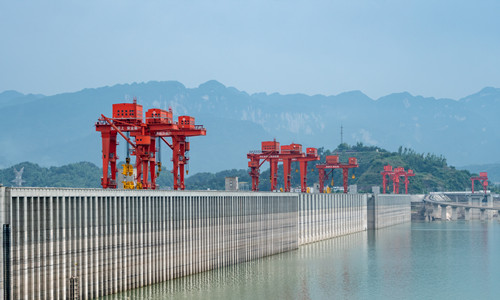
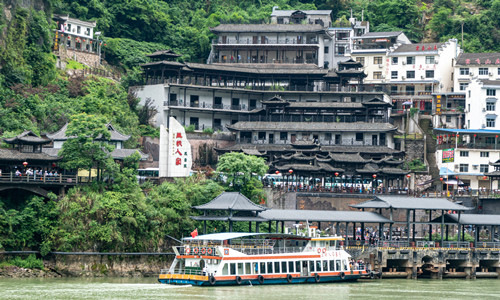
Today, you can also practice Tai Chi in the morning. After breakfast, we will We change to a boat and go to Shennong Stream.
According to legend, in ancient times, the plague could not be cured. There was crying everywhere, and there was hunger everywhere. In order to save the people, Shen Nong, the chief of the tribe named Jiang in ancient China, came to the northwest of Hubei in the dangerous mountains and dense forests, tasting all kinds of herbs, collecting herbs to cure diseases. On his way to collect herbs, he could not climb a particularly high cliff. So, he put up thirty-six sky ladders and climbed up. Later, a dense virgin forest grew out of the place where the ladder was built. When he came down from the top of the mountain, he found his way blocked by a stream. At this time, a wooden boat suddenly drifted from the upstream to take him out of the predicament. Later, people called the stream that Shen Nong borrowed to drift down the mountain Shennong Stream.
Then we will go back to the boat for lunch. After a short rest, the cruise ship continues its journey, passing through Wu Gorge and Qutang Gorge along the way.
Wu Gorge is the most coherent and orderly gorge of the Three Gorges. The twelve peaks of Wushan Mountain, located on the north and south sides of Wuxia Gorge, are the most famous scenic spots. Among them, the Goddess Peak is the most beautiful. Goddess Peak, also known as Wangxia Peak. A huge stone stands out in the clouds of Qingfeng, just like a slim and beautiful girl, so it is called Goddess Peak. Every day, it is the first to usher in the morning, and the last to send off the sunset, hence the name Wangxia Peak.
Next, we will see the Qutang Gorge. Qutang Gorge, also known as Kui Gorge, is eight kilometers long. It is the shortest of the Three Gorges, but the most magnificent and steep. It is famous for its majesty.
Tip: You can visit White Emperor City at your own expense. White Emperor City, also called White Emperor Temple. There are many poems, inscriptions and cultural relics, which are of great ornamental value. Many famous poets, such as Li Bai, Tu Fu and Su Shi, have ascended the White Emperor and left a large number of poems, so the White Emperor City has the reputation of “Poetry City”.
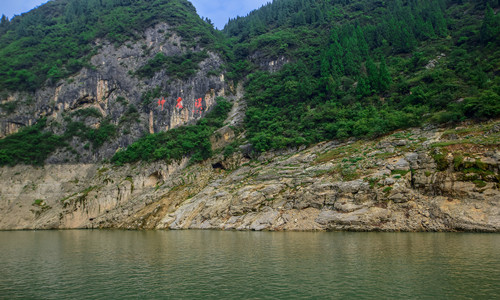
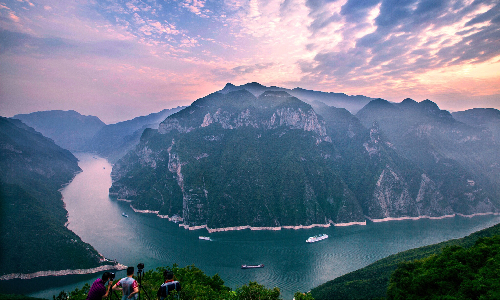
Today, our trip begins in the afternoon. You can rest in the hotel in the morning or get up early to practice Tai Chi.
In the afternoon, we will go to Fengdu “Jade Emperor”. Jade Emperor is a God in ancient Chinese mythology. The whole scenic spot strives to interpret the religious beliefs of Confucianism, Buddhism and Taoism from the perspective of cognitive civilization, and to reproduce the understanding, inheritance and dissemination of the excellent traditional culture of China for 5000 years in the present era with the belief culture system as the carrier of expression.
In addition, you can also choose to visit Fengdu “Ghost City” at your own expense. This is a famous historical and cultural city originated in the Han Dynasty (202 B. C.-220 A. D.), which is the destination of human dead. It is not only a legendary ghost city, but also a treasure house of folk culture and art integrating Confucianism, Taoism and Buddhism. It is one of the most famous human landscapes on the Yangtze River Golden Tourist Line.
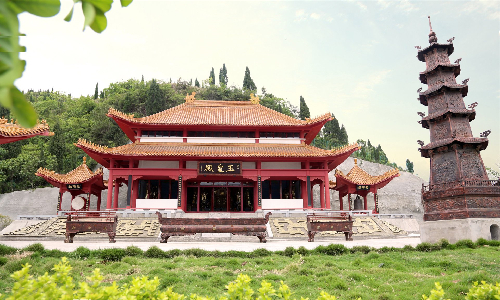
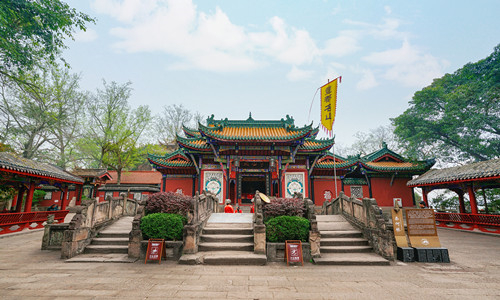
 Chengdu
Chengdu Chongqing’s journey is come to an end and we will go to Chengdu. About 8:30-09:00. We will disembarkation in Chongqing, and we have booked estimated train G6004 11:12/13:19 for you. After you arrive in Chengdu, the tour guide will wait for you at the station. Then, we will send you to the cruise and check in.
After arriving in Chengdu, you can choose to rest in the hotel, or you can choose to visit the following scenic spots on your own:
 Xi’an
Xi’an This morning, we will go to Chengdu Research Base of Giant Panda Breeding. It is a well-known research Institute for the protection of rare and endangered wildlife, such as giant pandas, which integrates scientific research and breeding, protection and education, education and tourism, and panda culture construction.
It completely simulates the living environment of giant pandas in the wild, with lakes, streams, bamboo forests, lawns and so on, raising more than 100 giant pandas. In addition to pandas, you can also see peacocks, egrets and other small animals. The Sun Delivery Room and the Moon Delivery Room have just born or a few months old panda Tuanzi, which is very cute.
After lunch, we will go to Wenshu Monastery. It is a famous Buddhist temple, which collects many precious cultural relics and tens of thousands of Buddhist scriptures and documents. There are more than 300 Buddha statues. Among them, there is a Burmese jade Buddha, which is extremely precious because it was invited by master who walked to Burma. In addition, you can also taste the unique Gaiwan tea and enjoy the folk artists' playing and singing.
Here, the trip to Chengdu is over. After a short rest, we will transfer you to the railway station for the next scenic spot, Xi'an. You will probably take estimated train D1946 17:27/21:22 to Xi'an. We will arrange a tour guide to pick you up and take you safely to the hotel to rest.
Xi'an is a world famous historical and cultural city with long history. It is the city with the longest capital, the most dynasties and the greatest influence in Chinese history. Xi'an enjoys the reputation of "natural history museum" due to its long history and cultural accumulation.
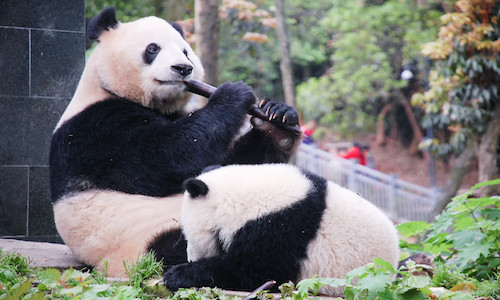
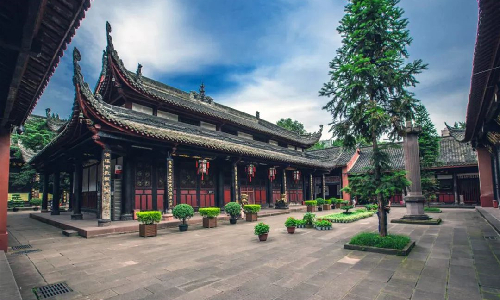
The first attraction in Xi’an is the Terra Cotta Warriors and Horses Museum. It is located in the northeast of Xi’an, and it is about an hour’s drive (about 40 kilometers from the city center). It is a heritage museum built on the original site of the Terra Cotta Warriors and Horses which were believed to guard the first Emperor Qinshihuang of China in his afterlife. It is also the biggest ancient military museum in China.
There are three pits in the museum. Pit 1 covers the largest area (around 14,260 square meters). A large number of terracotta figurines and horses were buried here, as well as many bronze weapons. Their facial expression, hairstyle, and gestures of terracotta figurines show that they are having different characters. The depicting of terracotta horses is very subtle. Some are with erected ears and some are roaring with their mouths open. The second pit is richer in content and more complete in the kinds of armies than pit 1. Pit 3, with the most colorful terracotta figurines, is the smallest and the only one that was not burned so far. The museum, known as “the eighth wonder of the world”, will surely give you a visual impact.
After lunch, we will visit the Big Wild Goose Pagoda and the ancient City Wall. The Big Wild Goose Pagoda is located in the Ci’en Temple, and it is one of the famous Buddhist pagodas in China. Established in 625, the brick tower is with a total of 7 floors.
The name of the pagoda came from an interesting story. It is said that Master Monk Xuanzang was living in a temple when he went on a pilgrimage for Buddhist scriptures in ancient India. One day, the monks of the temple were sad because they couldn’t have meat to eat. That day was the Bodhisattva Giving Day. A monk looked at the sky and sighed, “the merciful Bodhisattva will not forget what day it is today.” At that time a group of geese was flying by in the sky, and the first goose fell to the ground and died. The monks were shocked, and they believed that it demonstrated the mercy of and it was Bodhisattva who gave meat for them. Since then, for commemoration, each monk in the temple would not eat meat. They built a “wild goose tower” where the wild geese landed. After Monk Xuanzang returned to China, he designed and built the Wild Goose Pagoda according to the form of the tower in India.
Half a century later, the Jianfu Temple another famous temple in Xi’an, was built. The two towers are far from each other and have different styles. However, because the Jianfu Temple is smaller than the Wild Goose Pagoda, people call it the Small Wild Goose Pagoda, and the name of the wild goose pagoda in the Ci’en Temple is changed to the Big Wild Goose Pagoda.
Next, we are going to the ancient City Wall. It is the most complete ancient city wall and the second longest in China. The wall as the military defence system in ancient China is surrounded by a moat. One of the 18 gates of the wall, South Gate (Yongning Gate) is the very place for the grand welcoming ceremonies and you should miss it. You can choose to walk or ride a bicycle on the wall. The road paved with bricks on the wall is not smooth, so you should pay attention to safety when riding.
Optional Activities:
1. If you are interested in the snake of Xi’an, you cannot miss the Muslim Quarter, the snack street of Xi’an. It is the place where foreign tourists must go when they first visit Xi’an. There are so many snack shops on both sides of the street. You can eat nearly 100 kinds of special snacks along the street, such as Chinese Hamburger, Biang Noodle, Mutton Shashlik, Steamed Cake, Donkey Hoof Noodle, Pita Bread Soaked in Lamb Soup, Steamed Cold Noodle, and so on.
2. The Grand Tang Mall is the very place to feast your eyes and taste buds. Here, you can watch the live performances represented by Back to the Big Wild Goose Pagoda and Back to Chang'an, enjoy the music fountain, and taste the special snacks of Xi’an on the snack street. If you change into the Tang suit, you will have a feeling of coming to the Tang Dynasty (618-907).
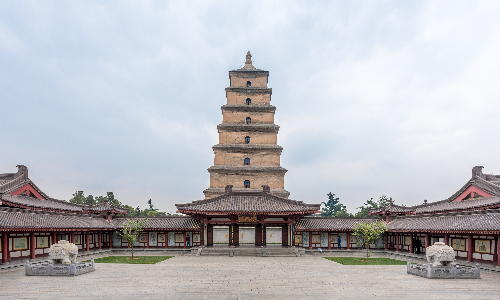
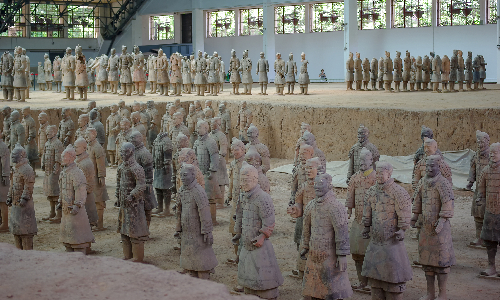
 Beijing
Beijing Today we will go to Beijing, the capital of China. In the morning, you will take the estimated flight CA1232 11:00/13:15 to Beijing.
Beijing, also called Beiping, is the national political and cultural center and international hub. It is a famous historical and cultural city. It is known as China’s six ancient capitals together with Xi’an, Luoyang, Kaifeng, Nanjing, and Hangzhou.
The first place in Beijing is Tian’anmen Square. It is the largest urban square in the world, with a total area of about 440,000 square meters. It is so large that it can host events for as many as one million people to attend. In ancient times, it was the royal forbidden area and protect by palace walls. The square is also a witness to China’s modern revolution. Many historical events have taken place here. Now, there is a very solemn flag raising ceremony here every morning. If you want to have a look, you should get up very early and occupy the best viewing position.
Then, we are going to the Forbidden City (closed each Monday). The former imperial palace of the Ming and Qing Dynasties is also known as the Palace Museum. While appreciating the paintings, calligraphy, ceramics, and antiquities of the museum, you should pay attention to the magnificent architectural complex. There are three palaces in it: the Taihe Palace, the Zhonghe Palace, and the Baohe Palace. The Taihe Palace is the largest wooden palace in China, and it was the place where the emperors of the Ming and Qing Dynasties summoned all officials, issued orders and held celebrations. The Zhonghe Palace was used for practicing etiquette. The Baohe Palace was the place where the emperors entertained princes and ministers. If you have watched the film The Last Emperor, you will find that it was shot in the Forbidden City.
It is time for lunch. You can have a rest now.
Next, we are going to the Temple of Heaven. It is a place where emperors of the Ming and Qing Dynasties offered sacrifices to gods and prayed for harvest.
When we come to the temple of heaven, we must go to the Huanqiu Altar. It has an outer circle and an inner circle. The number of steps and guards on the altar is nine or a multiple of nine. There are nine huge fan-shaped stone slabs in the first circle of the periphery, 18 in the second circle, and 81 in the outermost Ninth Circle. According to the Chinese Yin Yang and the five elements theory, nine is the number of extreme Yang, so the ancient craftsmen used this number to give the idea of sublimity at the round mound platform. Every winter solstice, the emperor would be here for a few days. When speaking here, his voice was particularly loud enough. You are strongly recommended to experience this strange effect and tell God their good wishes like the emperor of that year.
Next, we will go to the Summer Palace. This is a large landscape garden for the royal family to avoid heat in the Qing Dynasty. Besides the beautiful scenery in the palace, you cannot miss this ancient Chinese legend, the story of Cowherd and Weaver Girl. Now on the east bank of Kunming Lake in the Summer Palace, there is a bronze bull, which is known as the embodiment of cowherd. On the west bank, there is the attraction of Pictures of Framing and Weaving, which is known as the embodiment of weaver girl. They face each other from a distance across the Kunming Lake. The origin of these two landscapes stems from the story of Cowherd and Weaver Girl.
Optional Dinner:
When it comes to Beijing’s food, you may first think of Beijing Roast Duck. Now, you have come to Beijing, you should not miss this opportunity to taste it. Beijing roast duck is known as the “delicacy in the world” for its red color, tender meat, mellow taste, fat but not greasy characteristics. To eat Beijing roast duck, you can dip a good piece of roast duck into mashed garlic and sweet flour sauce, which adds a hint of spicy flavor to the delicious flavor and makes the flavor more unique. Many customers especially prefer this kind of seasoning.
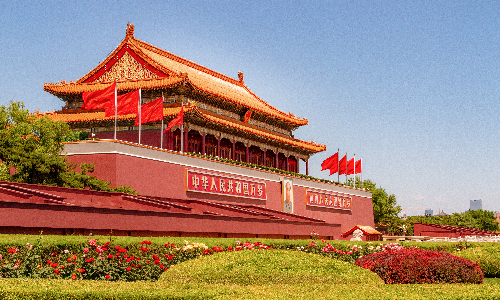
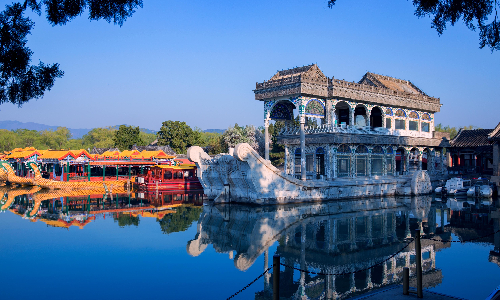
Today is the last day to enjoy the charm of Beijing. After breakfast, we will go to the Ming Tombs. It is located in the north of Beijing and takes an hour (about 50 KM) from the city center.
The Ming Tombs refers to the tombs of thirteen emperors of the Ming Dynasty. It is the largest existing imperial mausoleum complex in the world, covering an area of more than 40 square kilometers. We will see the Ding Tomb of Ming Tombs and the Sacred Way. Ding Tomb of Ming Tombs is the mausoleum of Zhu Yijun, the thirteenth emperor of the Ming Dynasty (1368-1644). Two of his queens are buried here. It is the only one of the Ming Tombs that has been excavated. The Sacred Way is the leading part of the construction of Changling Mausoleum, with a total length of about 7.3 kilometers.
After lunch, we will drive southeast in about 1 hour and 40 KM to Badaling Great Wall. There is a saying in China that “He who doesn’t reach the Great Wall is not a true man”, so Badaling Great Wall is the very attraction you must visit. Originally the military defence system in ancient China, the Great Wall is now the very site for people to appreciate the magnificence of China’s ancient culture. Badaling Great Wall is the essence of the Ming Great Wall, up to 1015 meters above sea level, divided into two parts of the South Great Wall and the North Great Wall. There are seven watchtowers in the South Great Wall and 12 watchtowers in the North Great Wall, which is more difficult to climb.
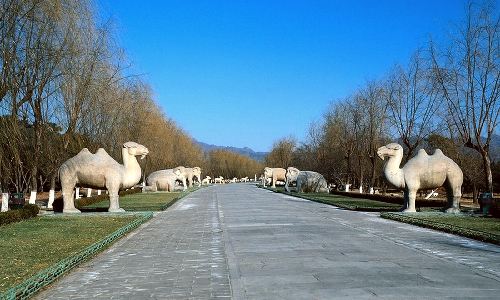
Now, our trip is coming to an end. Your guide will take you to the airport according to your flight. Thank you for choosing us. We sincerely hope you have harvested happiness on this trip. We are looking forward to meeting you one more time.
Author: Wang Mengwei
| City | Five Star hotel list | Four Star hotel list |
|---|---|---|
| Shanghai | Ocean Hotel Shanghai | Ambassador Hotel |
| Yangtze River Cruise | Victoria Anna | Victoria Anna |
| Chengdu | Sofitel Chengdu Taihe | Holiday Inn Express Chengdu Jinniu |
| Xi'an | Tianyu Gloria Grand Hotel Xi'an | Sunworld Dynasty Hotel |
| Beijing | Sunworld Dynasty Hotel Beijing Wangfujing | Sunworld Hotel Wangfujing |
 |
![]() About your child or infant, please contact us for a discounted price.
About your child or infant, please contact us for a discounted price.



We started with a few days in Beijing & ended in Shanghai, from where we visited the Forbidden City and Great Wall. In between we visited Terra Cotta Warriors Museum, Panda Base, Shanghai Disneyland.

We had a wonderful holiday in China which will remain long in the memory. China is a breathtakingly beautiful country full of splendid temples and palaces, mountains and rivers, peaceful rural scenes and bustling shopping streets.
 QUICK ENQUIRY
QUICK ENQUIRY